Dear all,
After reading alot of articles here on the forum and not being able to solve my problem, I decided to post a thread and ask for some proffesional assistance, I hope someone can, and is willing to help me out. Pictures of the tank/problems/under the microscope attached.
I think (I am quiet sure of that, that I face a dino related problem, however I am not sure on identifaction of the species).
The problem in several steps:
1. I face red patches in the sand on the right side of the tank at the substrate and in the left top on the life rock (upon inspection under the microscope I found Cyano bacteria as well as small Dino's).
2. I face green and brownish patches on the sand and low life rock on the opposite side of the tank, upon inspection under the microscope I also found small Dino's as well as as Cyano bacteria.
3. I face long brownish strings on my gorgonians (which now refuse to open) my zoanthids (same story) and my Hystrix corals, upon inspection under the microscope I literally found thousand and thousands of Dino's.
Situation of the tank:
The tank is a 200 liter tank with a 40 liter sump, I use a Hydra 52 HD, 2 tunze Powerheads and 1 Tunze main pump, I also use an oversized skimmer and an 11 watt UV (after the last dino outbreak which literally smothered all corals, way worse than now). I tried using Fauna Marine Dino X with limited succes and also Blue vet Cyano clean and the German Korallenzucht Cyano clean all with limited succes.
Since I live in the Netherlands Chemiclean is not an option since that is illegal and unavailable here (due to the anti biotic components).
The tank houses mushroom species (rhodactic, Ricordea & discosoma), Several Euphyillia's, several acropora's, several leather corals & several montipora's which are all doing fine, the only corals having diffulcties are: my 3 different gorgonians, my different Seriotopora Hystrix & my zoanthids.
The fish present (sorry tang police) are: 1 purple tang, 1 picasso tang, 2 occelaris, 2 kauderni's, a lawnmower blenny & a centropyge Bispinosa, which are all doing fine (also some heremits some snails, and 2 red banded shrimp also doing fine).
Water parameters:
Salt: 1.026
Temp 26.0
Ph: 8.0
No2 0
Nh4 0
No3 10
Phosphate 0 (i know this is part of my problem I started dosing po4 3weeks ago but still cannot measure it with my testkist)
CA 420
Mg 1240
The tank has been running since march 2020, using Idonesian Live rock that I bought fresh for my previous (smaller aquarium) and cycled a year in my other tank, added with dry dead rock.
All corals not affected by the Dino's are showing good growth.
Kindly help me formulate a battle plan and help me identify the problem (dino strain) @taricha I read wonderfull things about you and hope you can help me with Identification.
Thanks!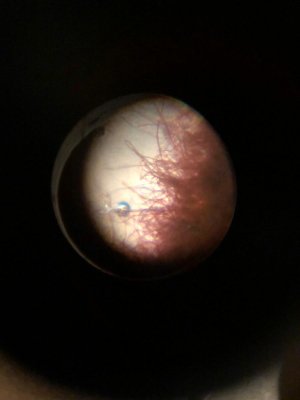
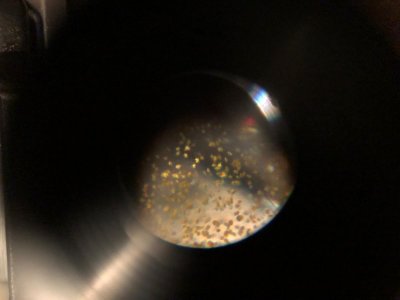
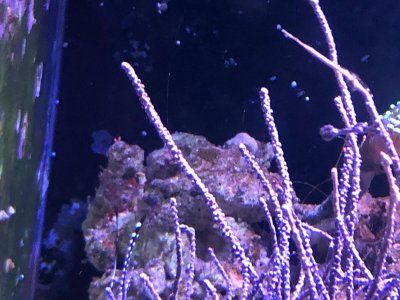
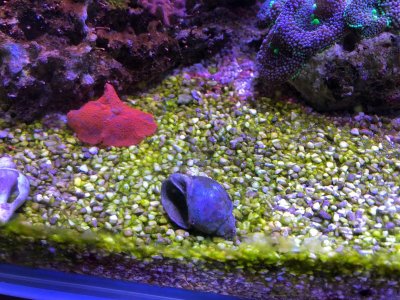
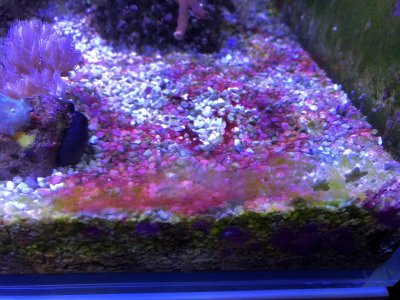
After reading alot of articles here on the forum and not being able to solve my problem, I decided to post a thread and ask for some proffesional assistance, I hope someone can, and is willing to help me out. Pictures of the tank/problems/under the microscope attached.
I think (I am quiet sure of that, that I face a dino related problem, however I am not sure on identifaction of the species).
The problem in several steps:
1. I face red patches in the sand on the right side of the tank at the substrate and in the left top on the life rock (upon inspection under the microscope I found Cyano bacteria as well as small Dino's).
2. I face green and brownish patches on the sand and low life rock on the opposite side of the tank, upon inspection under the microscope I also found small Dino's as well as as Cyano bacteria.
3. I face long brownish strings on my gorgonians (which now refuse to open) my zoanthids (same story) and my Hystrix corals, upon inspection under the microscope I literally found thousand and thousands of Dino's.
Situation of the tank:
The tank is a 200 liter tank with a 40 liter sump, I use a Hydra 52 HD, 2 tunze Powerheads and 1 Tunze main pump, I also use an oversized skimmer and an 11 watt UV (after the last dino outbreak which literally smothered all corals, way worse than now). I tried using Fauna Marine Dino X with limited succes and also Blue vet Cyano clean and the German Korallenzucht Cyano clean all with limited succes.
Since I live in the Netherlands Chemiclean is not an option since that is illegal and unavailable here (due to the anti biotic components).
The tank houses mushroom species (rhodactic, Ricordea & discosoma), Several Euphyillia's, several acropora's, several leather corals & several montipora's which are all doing fine, the only corals having diffulcties are: my 3 different gorgonians, my different Seriotopora Hystrix & my zoanthids.
The fish present (sorry tang police) are: 1 purple tang, 1 picasso tang, 2 occelaris, 2 kauderni's, a lawnmower blenny & a centropyge Bispinosa, which are all doing fine (also some heremits some snails, and 2 red banded shrimp also doing fine).
Water parameters:
Salt: 1.026
Temp 26.0
Ph: 8.0
No2 0
Nh4 0
No3 10
Phosphate 0 (i know this is part of my problem I started dosing po4 3weeks ago but still cannot measure it with my testkist)
CA 420
Mg 1240
The tank has been running since march 2020, using Idonesian Live rock that I bought fresh for my previous (smaller aquarium) and cycled a year in my other tank, added with dry dead rock.
All corals not affected by the Dino's are showing good growth.
Kindly help me formulate a battle plan and help me identify the problem (dino strain) @taricha I read wonderfull things about you and hope you can help me with Identification.
Thanks!


















